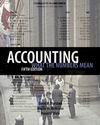 Accounting: What the Numbers Mean, 5/e David H. Marshall,
Millikin University
Wayne W. McManus,
International College of the Cayman Islands
Daniel F. Viele,
Webster University
Explanatory Notes and Other Financial Information
Chapter 10 Outline
General Organization of Explanatory Notes- Significant Accounting Policies
- Depreciation method.
- Inventory valuation method.
- Basis of consolidation.
- Income taxes.
- Employee benefits.
- Amortization of intangible assets.
- Earnings per share of common stock calculation.
- Stock option and employee stock purchase plans.
- Details of Other Financial Statement Amounts
- Reporting to the Securities and Exchange Commission.
- Other Disclosures
- Accounting change.
- Business combinations.
- Contingencies and commitments.
- Events subsequent to the balance sheet date.
- Impact of inflation.
- Segment information.
- Management's Statement of Responsibility
- Financial statements are the responsibility of management--not the auditors.
|
 |  |  | Management's Discussion and Analysis |
 |  |  | Five-Year (or Longer) Summary of Financial Data- Adjustment of per share data for stock dividends and stock splits.
- Supplemental disclosures--not part of the financial statements themselves.
|
 |  |  | Independent Auditors' Report |
 |  |  | Financial Statement Compilations |
| 

 2002 McGraw-Hill Higher Education
2002 McGraw-Hill Higher Education